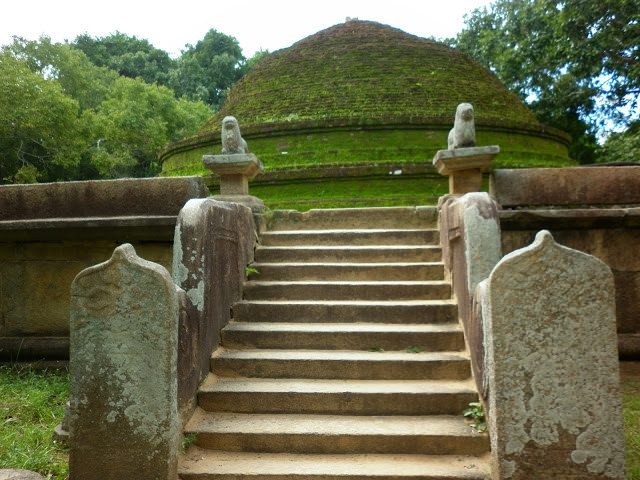Magul Maha Viharaya
The day was bright and the sea a glittering turquoise blue with a strong wind sweeping over it. Some people standing on a beach saw an object shining with the rays of the sun being tossed to and fro by the ocean waves. They waited till the object advanced towards the shore and was surprised to see that it was a gold-gilded canoe carrying a beautiful damsel in it.
They ran towards the palace and informed the King that a golden-canoe was coming ashore with a beautiful princess in it. The King hastened towards the beach but found the boat gone. "Ko Kumari" inquired the King? The boat had been swept away by strong winds towards the village Komarigama (coined with the words Ko kumari) in Arugam Bay. (The canoe had not been able to anchor at Kirinde due to its rocky environment). On inquiries made King Kavantissa was informed that the damsel in the canoe was Princess Devi, daughter of King Kelanitissa of Maya Rata, who was offered as a sacrifice to appease the wrath of the sea-gods as the sea waters threatened to drown villages.
King Kavantissa then hastened to meet the Princess and married her in keeping with traditional customs, and she became Queen Vihara Maha Devi. " The Magul Poruwa" said to be of the Royal couple could be seen amongst ancient ruins in a temple called "Magul Maha Viharaya" in Lahugala. Princess Devi's canoe had been washed ashore at Arugam Bay ( coined from the words "ara -gama") and not Kirinde. This is folklore -- as related to us by the Chief Priest of the ancient Lahugala Temple Ven. Hulanduwe Ratanasara Thera.
Driving along the Wellawaya-Moneragala road after passing Siyambalanduwa for another seven miles one could reach Lahugala where Magul Maha Vihara or Ruhunu Maha Vihara lies.
We visited Magul Maha Viharaya which is in ruins today. Ven. Hulanduwe Ratanasara Thera the 5th generation descendent of the Uva-Wellassa lineage which administered the Magul Maha Vihare is the present Chief Priest. Lahugala belonged to the Ruhunu Kingdom of ancient Lanka. The entire Vihara complex had covered an extent of around 10,000 acres where ruins of a palace, moonstone, monastery, bo-maluwa, stupas, ponds etc. were found scattered all over. A headless white marble Buddha statue was seen lying horizontally in one part of the ruins, which sometimes people step on, Ven. Ratanasara said, taking us round the complex.
The history of this temple goes back to the time of King Dathusena who ruled Anuradhapura from 516 AD to 526 AD. The pillar inscription testifies the founder of the Vihara as King Dathusena. The language and the script can be dated to the 14th century.
There is also a stone wall three to four feet in height. This reminds of a fortress which was erected to protect from outside attack. There is also an entrance to the fortress. The moonstone found on the left side has unique features with a row of elephants and creepers followed by a row of lotus petals. The Chief Priest explained that among other unusual features, the row of elephants in the moonstone with their mahouts was exceptional. In this moonstone with three to four in height and five to six feet wide, the row of elephants has a man following an elephant with his goad clinging on to the animals. This moonstone is said to be the only one of its kind in the country.
There are rock pillars similar to Lovamaha Prasada in Anura-dhapura. There is also ruins of a Dagaba about 30 feet in height. There are three rows of steps leading to the Dagoba on three sides and on the lift side is Bodhighara and also rock inscription protected by an iron railing.
The Ven. Thera showing us round the ruins of the vihara complex observed that there were several villages round the temple and people had fled due to unrest. With the ongoing peace process many were returning to their original places. A perahera has been planned along with other religious ceremonies to be observed during Poson the Ven. Thera said.
We then visited Muhudu Maha Viharaya at Arugam Bay. The wide white beach was endless, stretching for miles and miles. There were excavated ruins and stone pillars which provided evidence of an ancient kingdom which had flourished. The Chief Priest of Muhudu Maha Viharaya, Ven. Kataragama Siriratana Thera supporting Queen Vihara Maha Devi's story as related to us by the Lahugala Viharaya Chief Priest, showed us partly ruined stone statues two of which were believed to be of King Kavantissa and Viharamahadevi. The moonstone which had been in existence near a ruined "Buduge" had been removed by treasure hunters and the "Mura-gal"had been replaced awkwardly.
Ven. Siriratana Thera showed us ruins and stone pillars of an ancient structure excavated on the vast stretch of the beach, where, he said, a stupa had been erected to mark the spot where Princess Devi had landed. The monk living by himself protecting the ruined temple,is supported by about 12 families living in the vicinity who provide him with the "dana".
There were sand dunes forming part of the endless beach bordering a tranquil turquoise sea and at one end was the Arugam Bay and the "Ula" with a natural harbour. Several fishing huts were seen dotting the area. Both Chief Priests at Lahugala and Arugam Bay said that the ruins found in these places supported the existence of a royal kingdom of ancient Ruhunu Rata, and believed if chronicled had not sufficiently surfaced. The Ven. Theras said that these places were historically and culturally important and their conservation was of utmost importance to preserve the country's rich heritage. (@CDN)
*The content and some of the images herein are the property of their respective owners.












No comments: